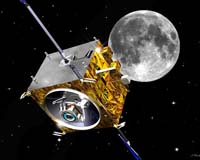--5:36 AM PDT
I've just got up on the westcoast to live blog the launch! Have my coffee in hand. The Flame Trench does such a great job
here. The white room crew is working. All crew members are abroad now. They will be doing com checks next.
--5:40 AM PDT
NASA's Launch Blog is
here.
--5:45 AM PDT
Com Checks!
--5:53 AM PDT
Com Checks all done. (Air to ground)
--5:58 AM PDT
Ready for Hatch Closure.
--6:00 AM PDT
T- Minus 1 hour and 18 minutes. Weather looks good at 20% not making launch. Showers are more than tem miles off the Cape. Green to go. Hatch is closed. Sealing the hatch and final close out of white room.
--6:12 AM PDT
T- Minus 1 Hr. 7 Mins. Weather Green, Leek checks now. No major issues right now.
--6:28 AM PDT
Interesting over at the Live Launch NASA Blog. This is the 200th time a shuttle has been tanked up. That is over 60 million gallons of Liquid Hydrogen!
--6:33 AM PDT
Shuttle training plane is up and doing final weather checks. Steve Lindsey from the last Discovery crew is on the plane.(T-Minus 45mn)
--6:40 AM PDT
Shuttle offical Launch time (In Eastern) is 11:14:55 AM EDT to coordinate with ISS docking.
--6:51 AM PDT
Clouds approaching but still in Green for weather. Steve Lindsey and Kent Rominger are flying the STA (Shuttle Training Aircraft) to check it out.
--6:58 AM PDT
Close out team leaving pad. T-Minus 20 for a ten minute hold. Clouds not a problem at this time.
--7:10 AM PDT
Out of T-Minus 20 hold and counting. Clouds still being evaluated.
--7:15 AM PDT
Emergancy purge for engines are being checked.
--7:21 AM PDT
T- Minus Nine Mins and holding. Final hold before launch.
-- 7:30 AM PDT
Clouds will be thin at 15,000 feet. KFC weather still a go.
--7:35 AM PDT
Generator failed. Looking into it now. It's a backup and will not violate flight rules via Flame Trench.
--7:46 AM PDT
History of Atlantis via NASA Launch Blog:
This is the 27th flight of Space Shuttle Atlantis, which was delivered to the Kennedy Space Center in April, 1985. Atlantis' last launch was Oct. 7, 2002, carrying the S-1 Truss to the International Space Station. It was the fourth spaceship in the orbiter fleet, and first lifted off on Oct. 3, 1985, on the second Air Force dedicated mission. Atlantis is named after a two-masted sailing ship that was operated for the Woods Hole Oceanographic Institute between 1930 and 1966. Two of the most notable payloads it has flown are Galileo and Magellan.
--8:00 AM PDT
14 mins to launch. STA up again to check cealing levels on clouds.
--8:01 AM PDT
Launch polls are in process. All Go! Yeah!
--8:03 AM PDT
Launch clock to go in 3 (Minutes T-9) and holding.
--8:06 AM PDT
T minus 9 and counting!
--8:08 AM PDT
Orbital access arm is being retracted.
--8:10 AM PDT
Less than 5 minutes to launch.
--8:11 AM PDT
Engine check with controlers. T-Minus 4 to go.
--8:12 AM PDT
T-Minus 3 minutes.
--8:14 AM PDT
T-minus 2 to go.
--8:15 AM PDT
10, 9, 8, 7, 6, 5, 4, 3, 2, 1, Lift off!
--8:19 AM PDT
3 minutes into launch. Had to go run into the living room to watch with the kids. Neg return to KSC now.
 Attired in Russian Sokol launch and entry suits, astronaut Michael E. Lopez-Alegria (right), Expedition 14 commander and NASA space station science officer; cosmonaut Mikhail Tyurin, flight engineer representing Russia's Federal Space Agency; and spaceflight participant Anousheh Ansari join hands as they pose for a portrait in Star City, Russia.
Attired in Russian Sokol launch and entry suits, astronaut Michael E. Lopez-Alegria (right), Expedition 14 commander and NASA space station science officer; cosmonaut Mikhail Tyurin, flight engineer representing Russia's Federal Space Agency; and spaceflight participant Anousheh Ansari join hands as they pose for a portrait in Star City, Russia.
